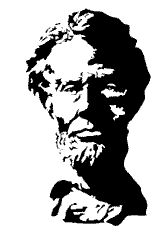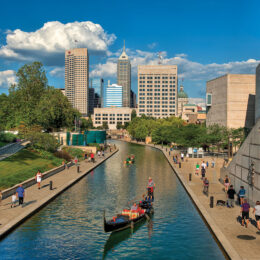Cooperative effort ‘earns’ Indiana $20 million Lincoln collection

Some of the items from the $20 million Lincoln Financial collection donated to Indiana include this 1860 campaign ribbon showing a beardless Lincoln. Lincoln grew his trademark beard after the election. At the top is a star-shaped 1864 campaign pin. Photos courtesy of the Indiana State Museum
“Determine that the thing can be and shall be done, and then we shall find the way.”
— Abraham Lincoln, 1848
(This article originally appeared in the February 2009 issue of Electric Consumer.)
This Feb. 12 marks Abraham Lincoln’s 200th birthday. But Lincoln-philes and historians in Indiana got to blow out the candles early… after holding their collective breath for months.
In December, Gov. Mitch Daniels announced that the Lincoln Financial Foundation chose Indiana to receive its collection of Abraham Lincoln artifacts and documents. The collection, valued at $20 million, made up the Lincoln Museum in Fort Wayne that closed last June.
It was time for a Hoosier celebration. The world’s largest private collection of memorabilia from Lincoln’s personal and presidential life was going to stay in Indiana — the state where the collection and Lincoln, the man and most of the boyhood folklore about him, were formed.
“We enter Lincoln’s bicentennial year with the goal of re-establishing Indiana’s central place in his life,” the governor said Dec. 12 in announcing the foundation’s donation to the state, “… but this is no birthday gift. It was well earned by the excellent team that represented us all. Indiana pledges the most exquisite care and the widest possible public availability of these priceless pieces of our history.”
The collection now will be housed at the Indiana State Museum in Indianapolis and the Allen County Public Library in Fort Wayne.
The cooperative effort to win the collection faced stiff competition from other museums and historical repositories — including big names like the Smithsonian and Library of Congress in Washington, D.C., and the Lincoln Presidential Library and Museum in Springfield, Ill.
Among the more than 20,000 items in the collection are copies of the Emancipation Proclamation and the Thirteenth Amendment, both signed by President Lincoln; three-dimensional artifacts; artwork; thousands of documents; photographs; prints and rare books.
“It’s a phenomenal world-class collection,” said Dale Ogden, chief curator of cultural history at the Indiana State Museum. “It’s absolutely breathtaking.”
The collection includes:
- • More than 18,000 books and pamphlets
- 350 documents signed by Lincoln
- 5,000 original 19th century photographs, daguerreotypes and stereocards
- 7,000 prints and engravings
- Textiles including campaign memorabilia, flags and Lincoln-family clothing
The collection had been gathered by the Lincoln foundation since 1928 (please see the sidebar at the bottom of this story). Its museum opened in Fort Wayne in 1931 and became a destination for Lincoln enthusiasts, school kids and scholars.
“We are so pleased that Governor Mitch Daniels and the Indiana consortium came together to address our goal of making the Lincoln Financial Foundation Collection more accessible and visible,” said Sandi Kemmish, head of Lincoln Financial Foundation. “We are delighted that we have found a win-win for the collection and the people of Indiana.”
The three-dimensional artifacts from the collection will be exhibited in a redesigned gallery dedicated to Lincoln Financial at the Indiana State Museum in Indianapolis.
The books, manuscripts and printed materials will be in the care of the Allen County Public Library. The Fort Wayne library is already home to one of the largest genealogical collections in the world and has expertise in preserving, cataloging and digitizing rare books, manuscripts and records. The library intends to have most every page of the collection’s printed material digitized and accessible through the Internet.
Closed doors, opened opportunities
Last March, the Lincoln Financial Foundation announced it would close the Lincoln Museum at the end of June. The news hit Fort Wayne and the state like a thump to the head, especially with the timing. The Lincoln bicentennial was just beginning. The foundation stressed its desire to make the collection more accessible. But the decision drew a whirlwind of protest.
“It was a great museum, but people don’t have an appreciation for how expensive museums really are to maintain,” Ogden said, citing the high costs of preserving and securing artifacts, staffing, programming and publicity. It’s especially so, he added, for corporations like Lincoln Financial that “are not in the museum business.”
Ian Rolland, who retired in 1998 after serving 21 years as chairman and chief executive officer of the Lincoln National Corporation, said he wasn’t surprised by the closure. But the Fort Wayne community activist immediately saw what had to be done. He spearheaded the Indiana consortium dedicated to keeping the collection in Indiana. “I had something to do in assembling a good chunk of it, so my involvement in this was a natural thing,” he said.
The consortium didn’t include just folks from the Indiana State Museum and the Allen County Public Library. The Indiana Historical Society, Indiana State Library, Friends of the Lincoln Museum and the governor’s office also were involved. The way these different groups came together to earn Lincoln Financial’s favor spoke volumes, Ogden noted.
“It said there were people in Fort Wayne, people in Indianapolis, institutions in Fort Wayne, institutions in Indianapolis that could put this kind of proposal together and go toe-to-toe with many of the other major historical institutions in the country — and come out on top,” Ogden said. “I think that’s a pretty strong statement.”
“We really had this sense of camaraderie,” added Cheryl Ferverda, community relations and development manager with the Allen County Public Library. “We had a purposeful goal we wanted to obtain. When you make an assessment of the competition and find we were the ultimate winners, it was a formidable task.”
“A fair amount of people would not have given us a chance against a lot of the organizations,” Rolland added. “People in Indiana ought to feel good about it. Hands down we won it. We earned it. It was definitely something the state of Indiana deserved.”
Initially, some 40 institutions expressed interest in the collection. Ogden said the interview process with Lincoln Financial was rigorous. But with a $20 million asset involving one of the most beloved and important figures in history, he said Lincoln Financial wanted to make sure the collection would be in worthy hands. “From Lincoln [Financial]’s end, it was: ‘Why you? Why should you be entrusted with this collection?’ They were serious,” he said. “They were very conscientious in selecting an appropriate institution.”
After making the proposal, the consortium waited with bated breath as Lincoln Financial winnowed the field. Joining Indiana among the three finalists were the Springfield museum and the Gettysburg (Pa.) National Military Park.
When the final decision was made, Ferverda said there was elation, not just among the participants within the consortium, but also in the community which had feared losing a large piece of its heritage. “That collection was amassed in Fort Wayne. It originated here. To have it stay here meant so much to all of the community. It was a sense of pride, pride in ownership of the collection,” she said.
Indiana’s advantages
Kemmish praised the Allen County library’s “unparalleled abilities” to digitize documents and put them on the Web as one of the decisive factors in choosing Indiana’s proposal.
Another advantage in Indiana’s favor was something previously considered a shortcoming for the state museum. That was its relatively minor collection of Lincoln items.
The museum, located in a 7-year-old facility just west of the state capitol, features some items from Lincoln’s funeral stop in Indianapolis, a cabinet made by Lincoln’s father that a young Abraham might have worked on, other odds and ends, and the letters of Caleb Smith (a Hoosier contemporary of Lincoln in Congress who served as his first Secretary of Interior).
“Lincoln Financial was interested in maintaining its corporate identification with the collection,” Ogden said. “We can do that because, in large part, this will be our Lincoln holdings — as opposed to Springfield, for instance, where you would be subsuming the collection into an already existing collection.”
Ogden said Indiana’s proposal may have been the only one that committed to naming a physical space in its museum after Lincoln Financial. Though the entire collection will be owned by the state museum, Kemmish said, sharing the collection with the library played to each institution’s strength.
“The skills are different,” Rolland said. “The artifact is consistent with the museum, and the rest is consistent with what the library does.”
The museum plans to exhibit the core of the collection when it opens the new Lincoln Financial Gallery on Lincoln’s 201st birthday in 2010. That will coincide with the arrival and opening of the Lincoln bicentennial exhibition from the Library of Congress. The Library of Congress exhibit opens this Feb. 12 in Washington and then will travel to only five cities in the nation. Indianapolis was one of the chosen five even before the Lincoln Financial collection decision was made.
Ogden said some smaller items from the Lincoln Financial collection might start appearing sooner as the state museum takes physical possession of the collection by the end of June.
The Allen County Public Library will begin its monumental task of scanning and making the documents and books available on-line as it takes possession and catalogs the material. Ferverda said the digitized material will be available to anyone. “Regardless of where you’re accessing it — whether it’s in Honolulu, Hawaii, or Bluffton, Ind., you’ll be able to sit at your computer and access that information.”

“The Lincoln Family Album,” also part of the donated collection, includes these 1859 photos of sons Willie (left) and Tad. Along with family, the album features images the Lincolns collected of many famous people of their day, including the leading actor John Wilkes Booth — who would later assassinate Lincoln at Ford’s Theatre.
An endowment funded from private donations also will be established to maintain the collection at the two sites and make it available to wider audiences all around Indiana.
“We’re not done,” Rolland noted. “We have to raise some money, and the public will have an opportunity to contribute. That’s the next challenge to do all the things we want to do.”
Lincoln the Hoosier
Beyond the physical possession of the collection, the victory for Indiana was important in another way, Ogden noted. “It’s important psychologically to the state,” he said. “You can tell how important it was when the governor and the chief justice of the Supreme Court and a half dozen legislators and all the major media show up for the announcement.”
Up until just the last 20 years or so, Indiana, in general, seemed reticent in claiming its stake in the Lincoln story. But between the waters of the Ohio and the Wabash rivers — in Indiana — is where Lincoln lived from ages 7 to 21. This is where he became the man he was.
“The general perception over the last 150 years has been that Lincoln was born in Kentucky and then as a teenager moved to Illinois. Nothing could be further from the truth,” Ogden said.
“Historically,” he added, “there’s this reluctance to toot our own horn, as opposed to Texas, for instance, or Tennessee, or New York or California … You have these states that just beat their chests.’”
Indiana’s goal of re-establishing the state’s prominence in Lincoln’s life is not a stretch, Ogden emphasized. “All these myths and legends that American schoolchildren grew up with took place in Indiana.
“The whole honesty persona that was crafted after his death, walking a mile in the snow to return a borrowed book, sitting by the dim fire light reading the Bible or Shakespeare, learning to split rails. All these things every single fourth grader in America has studied since 1880 took place in Indiana,” he said.
Securing the Lincoln Financial collection for Indiana was a step to changing perceptions about Lincoln’s past … and Indiana’s future. “It says a lot about the state’s confidence in itself, about its willingness to commit to projects like Lincoln,” Ogden said.
“We’re committed to utilizing it. One of the reasons we ended up with the collection is we said we will make it available. People will see this collection,” he noted. “People will understand its importance.”
Story by Richard G. Biever, senior editor of Electric Consumer.
History of the Lincoln Museum and its collection
Five score and four years ago, Arthur Hall and a group of business leaders from Fort Wayne founded a new insurance company dedicated to the principles of dependability, honesty and integrity.
These 33 founders adopted the name of the 16th president, Abraham Lincoln, to represent the ideals their new company was founded upon.
 Hall, a lifelong admirer of Lincoln, wrote to Lincoln’s only surviving son, Robert Todd Lincoln. He gave the founders permission to use his father’s name and likeness in July 1905. Lincoln wrote, “I find no objection whatever to the use of a portrait of my father upon the letterhead of such a life insurance company named after him as you describe; and I take pleasure in enclosing, for that purpose, what I regard as a very good photograph of him.”
Hall, a lifelong admirer of Lincoln, wrote to Lincoln’s only surviving son, Robert Todd Lincoln. He gave the founders permission to use his father’s name and likeness in July 1905. Lincoln wrote, “I find no objection whatever to the use of a portrait of my father upon the letterhead of such a life insurance company named after him as you describe; and I take pleasure in enclosing, for that purpose, what I regard as a very good photograph of him.”
The company prospered, and in 1928 Hall took the opportunity to repay the Lincoln family by creating the Lincoln Historical Research Foundation, dedicated to the life and legacy of Abraham Lincoln. The foundation, under the leadership of Louis A. Warren, began to collect Lincoln-related material and opened the Lincoln Museum to the public in 1931.
Over the decades, the foundation expanded the collection which became the largest private Lincoln collection in the world. The museum continued growing and moved to larger facilities in 1977 and again in 1995 — when it opened a $6 million facility in downtown Fort Wayne.
Early last year, the Lincoln Financial Foundation, the owner and operator of the Lincoln Museum, announced it would close the museum on June 30, 2008. A new home for the museum’s collection of artifacts, memorabilia, and documents — where they could enjoy “greater visibility and public access” — was sought.
In December 2008, the foundation donated the entire collection to a consortium from Indiana that will divide the museum’s holdings between the Indiana State Museum in Indianapolis and the Allen County Public Library in Fort Wayne.
For more information
The Indiana State Museum
650 W. Washington St.
Indianapolis, IN 46204
Phone: 317-232-1637
indianamuseum.org
The Allen County Public Library
900 Library Plaza
Fort Wayne, IN 46802
Phone: 260-421-1200
www.acpl.lib.in.us



